Webs Expert Knitting Class taken with Erin Holman - always excellent!
Back: casted on 45 stitches.
Five stitch increases after ribbing: every seven stitches, three times and every eight stitches, three times. 42 rows up to armholes.
Great set in sleeves video by Erin Holman. I ended up also using this method for my Sonnavindkofte sweater that I was doing at the same time. It was a life-saver!
Shawl collar and button band: Using US 3 needles, picked 41 stitches for right button band (A-B), 15 stitches for start of collar (B-C), 30 stitches for back of collar (C-D), 15 stitches for left front of collar (D-E) and 40 stitches left button band (E-F). B through E are the four stitch makers added and used in the class for managing the short-rows for the collar. (B-E) = 60 stitches collar stitches. I’ve added a picture of Erin’s graphic for how all this fits together.
Buttonhole band: 4 buttons and 3 stitch buttonholes, involving 5 stitches. Started after three stitches and allowed 5 stitches between the 5 buttonhole-involved stitches. Three remaining stitches were left before the start of the shawl collar.
Shawl collar math: row gauge with US 5 = 7.25 * 2 inches = 14.5. Between markers C-D stitches = 30 stitches in top & back collar / 14.5 = 2.06 rounded to 2 = short row rate.
I tried doing the wrapped short-rows as taught in class for the shawl collar, but made a total mess of it and had to pull out the rows and go back to what I knew, German short rows and was happy with the results. The only adjustment from the pattern was that I had to knit or purl the stitch that I would have been wrapping. I then turned, slipped and added a double-stitch wrap over the needle.
For the bind-off for the body, I used the tubular bind-off for k1, P1 ribbing. Row 6 started the four rows of double-knitting that sets up the tubular bind-off. This is actually two rows (1 extra row) because of the double knitting, but it works out still looking balanced with the buttonholes. Because my gauge is pretty loose, the double knitting did show through more than I would have liked but the elasticity is nice.
Dorset buttons:
I was struggling to find the right buttons and one of the class participants mentioned Dorset buttons. I had previously read about the history of these and decided to give it a try. So happy with the results. I’m using this project page to keep track of resources I’m using to learn more about button making.
Added flower embroidery design from Embroidery on Knits to further brighten up my boring main color choice:
1. Wash away fabric stabilizer for
embroidery
2. Embroidery hoop that works well with knits
 cckillingsworth >
cckillingsworth >  notebook > projects > Webs WEKP Fearless Finishing "Seven Things" Baby Cardi
notebook > projects > Webs WEKP Fearless Finishing "Seven Things" Baby Cardi 

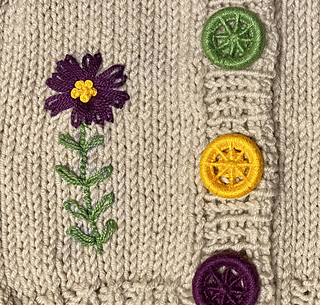
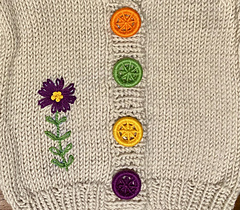
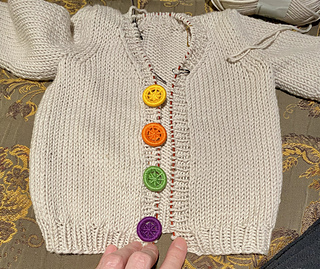
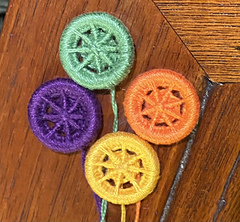
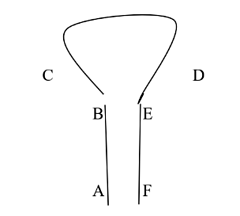


42332 projects
stashed
20238 times


 handspun
handspun queue
queue favorites
favorites friends
friends needles & hooks
needles & hooks library
library